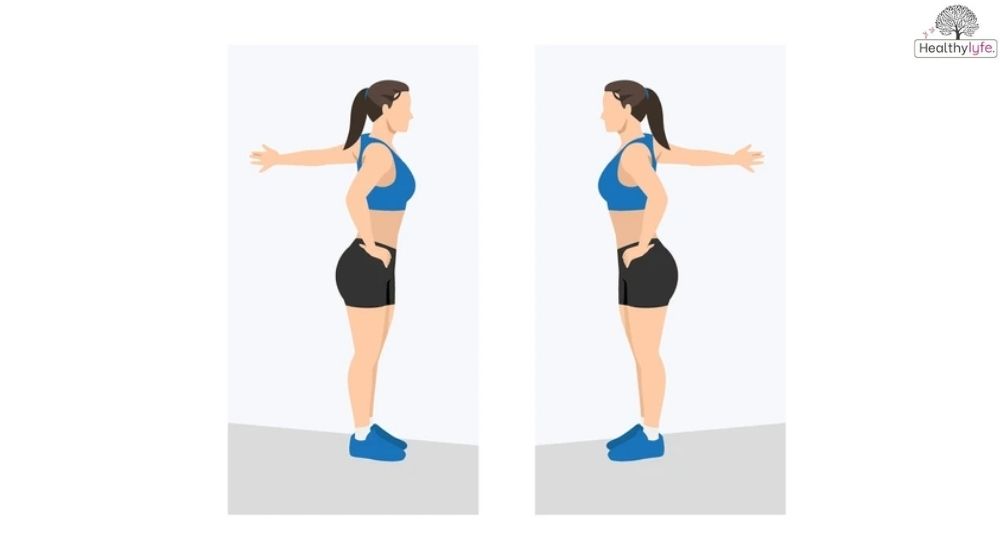Chest Stretch, What is it, Advantage, Best Tips And Diets Plan – By Healthylyfe
Learn how chest stretches improve posture, flexibility, and reduce muscle tension. Add this simple stretch to your routine for better comfort and health.
Introduction
A chest stretch is a simple and effective exercise that helps improve flexibility, posture, and relieve tightness in the upper body. Tight chest muscles, often caused by sitting too long or poor posture, can lead to discomfort and limited movement. Regular chest stretching opens up the chest, improves posture, and promotes better breathing. It’s an easy exercise suitable for all fitness levels and can be done anywhere. Try incorporating chest stretches into your daily routine for better flexibility, less pain, and improved overall well-being.
What is Chest Stretch?
A chest stretch is a simple exercise designed to stretch and relax the muscles in your chest, primarily the pectorals. These muscles can become tight from poor posture, sitting for long periods, or repetitive movements. A chest stretch helps open up the chest, improve flexibility, and relieve tension. By regularly stretching your chest, you can enhance your posture, improve breathing, and reduce discomfort in the shoulders and back. This stretch is easy to do and can be performed anywhere, making it a great addition to any fitness routine.
Types of Chest Stretches
Chest stretches come in different types, each designed to improve flexibility, reduce tension, and enhance posture. Whether you’re looking for a quick stretch or something deeper, these variations are easy to add to your routine. Here are some of the most popular chest stretches you can try:
- Standing Chest Stretch: This stretch involves extending your arms out and opening the chest while standing tall. It’s a great option to improve posture and release tension in the chest area.
- Doorway Chest Stretch: By placing your arms on a doorway frame and leaning forward, this stretch targets the pectoral muscles, helping to open up the chest and shoulders.
- Seated Chest Stretch: Sitting with your back straight, you can stretch your chest by clasping your hands behind your head or around your back. This is a great option for those with limited mobility or those who prefer sitting while stretching.
- Lying Chest Stretch: Lying on your back with your arms extended out to the sides, you can stretch the chest by gently lowering your arms toward the ground, creating an opening across the chest area.
- Chest Opener Stretch (Cobra Pose): A yoga-inspired stretch that helps open the chest and stretch the upper body. It involves lying on your stomach and lifting your upper body while keeping your legs on the floor.
Benefits of Chest Stretch [1]
Chest stretches are a simple and effective way to improve your overall health and well-being. Regularly stretching the chest can provide a range of benefits, from better posture to increased flexibility. These stretches help reduce tension, improve mobility, and make everyday activities easier. Whether you’re looking to feel more relaxed, improve your workout performance, or prevent discomfort from sitting all day, adding chest stretches to your routine is a great choice.
- Improves Posture
Chest stretches help open up the chest and counteract the effects of slouching or rounded shoulders. This can lead to better posture, making you stand taller and feel more confident. - Reduces Tension
If you spend long hours sitting or working at a desk, chest stretches can relieve tightness in the chest and shoulders, reducing stress and discomfort in the upper body. - Increases Flexibility
By regularly stretching your chest muscles, you improve flexibility in the upper body. This increased range of motion can make everyday movements, such as reaching or lifting, easier and more comfortable. - Enhances Breathing
Chest stretches help open up the lungs, allowing for deeper breaths and better airflow. This can be particularly helpful for improving your breathing capacity and overall relaxation. - Prevents Injury
Stretching your chest muscles regularly can prevent tightness or strain, reducing the risk of injury during physical activity or even when performing daily tasks.
Diet Plan for Chest Stretch
While chest stretches are excellent for improving flexibility and posture, pairing them with the right diet can further enhance your results. A balanced diet rich in nutrients supports muscle recovery, reduces inflammation, and promotes overall flexibility. For individuals incorporating chest stretches into their routine, consuming foods that aid in muscle repair, provide energy, and maintain joint health is key. Here’s a simple diet plan designed to complement your stretching routine and help optimize your results.
| Meal Time | Food Options | Benefits |
|---|---|---|
| Breakfast | – Oatmeal with berries and nuts – Scrambled eggs with spinach and avocado | Provides energy, supports muscle repair, and boosts flexibility |
| Mid-Morning Snack | – Greek yogurt with chia seeds – Apple with almond butter | Promotes muscle recovery and reduces inflammation |
| Lunch | – Grilled chicken or tofu with quinoa and vegetables – Salmon with sweet potato and greens | Supports muscle growth, reduces inflammation, and promotes joint health |
| Afternoon Snack | – Hummus with carrots and cucumber – Handful of mixed nuts | Provides healthy fats and protein for muscle repair |
| Dinner | – Grilled fish or lean beef with steamed broccoli and brown rice – Stir-fried vegetables with tofu | Rich in protein, vitamins, and minerals for muscle recovery and flexibility |
| Hydration | – Water – Herbal tea (e.g., ginger or turmeric tea) | Keeps muscles hydrated and reduces muscle tightness |
This diet plan includes nutrient-dense foods that support muscle health, aid recovery, and reduce inflammation, helping you get the most out of your chest stretching routine.
Tips for Success
To fully reap the benefits of chest stretches, it’s important to approach them with the right techniques and habits. Whether you’re looking to improve flexibility, alleviate tension, or enhance posture, following key tips will help you achieve the best results safely and effectively. These practical tips for chest stretches ensure you’re not only preventing injury but also maximizing your flexibility and range of motion. With the right approach, chest stretches can be a powerful addition to your daily routine.
- Warm Up Before Stretching
Warming up your body before chest stretches is essential for preparing your muscles and joints. A light warm-up, such as walking, jogging, or dynamic stretches, increases blood flow and reduces the risk of muscle strain. This helps your chest muscles respond better to stretching and prevents injury. - Avoid Overstretching
While it’s important to challenge your flexibility, overstretching can cause muscle strain and discomfort. Stretch to a point where you feel mild tension but not pain. Gradually increase your flexibility over time, ensuring you don’t push yourself too far beyond your current range of motion. - Maintain Proper Posture and Form
When performing chest stretches, focus on keeping good posture. Keep your shoulders back, your chest open, and avoid slouching. Proper form ensures that you are effectively targeting the chest muscles, improving your posture, and preventing any strain on the neck or back. - Focus on Deep Breathing
Breathing deeply while stretching helps relax your muscles, allowing for a more effective stretch. Inhale through your nose as you prepare for the stretch, and exhale slowly as you deepen the stretch. Deep breathing helps reduce tension and allows you to hold stretches longer and more comfortably. - Be Consistent with Your Routine
Consistency is key to making progress with chest stretches. Make stretching a part of your daily routine for the best results. Stretching regularly, even if just for a few minutes each day, will help increase flexibility, improve posture, and reduce muscle tightness over time. - Stay Hydrated
Proper hydration is important for muscle health and flexibility. Drinking plenty of water helps maintain muscle elasticity and keeps your muscles from becoming stiff. Staying hydrated can also reduce muscle soreness and tightness, which enhances the effectiveness of your chest stretches.
Conclusion
Adding chest stretches to your daily routine offers many benefits, including better posture, increased flexibility, and relief from muscle tightness. These stretches help open up the chest, improve breathing, and reduce discomfort caused by poor posture or sitting for long periods. Whether you want to improve flexibility, ease tightness, or boost your overall well-being, chest stretches are a great addition to your routine.
FAQs about Chest Stretch
What is a chest stretch?
A chest stretch is an exercise or movement designed to lengthen and loosen the muscles in your chest, particularly the pectoralis major and pectoralis minor.
Why is chest stretching important?
Chest stretching helps improve posture, increases flexibility, reduces muscle tightness, and can prevent injuries, especially in the shoulders and upper back.
Who should do chest stretches?
Anyone can benefit from chest stretches, particularly individuals with tight chests from prolonged sitting, poor posture, or strength training. It’s especially helpful for athletes and those who work at desks.
How often should I stretch my chest?
You can stretch your chest daily or at least 3–4 times per week, especially if you experience tightness or stiffness.
What are some common chest stretches?
Doorway stretch
Wall stretch
Standing chest opener
Camel pose
Floor chest stretch (prone pec stretch)
How long should I hold a chest stretch?
Hold a chest stretch for 15–30 seconds per repetition and repeat 2–4 times for optimal results.
Can chest stretches help improve posture?
Yes, chest stretches help counteract tight chest muscles, which can contribute to rounded shoulders and poor posture.
What equipment is needed for chest stretches?
Most chest stretches require no equipment. However, you can use tools like resistance bands, foam rollers, or stability balls for variation and deeper stretches.
Are chest stretches safe for everyone?
Chest stretches are generally safe for most people. However, those with shoulder or chest injuries should consult a healthcare provider before stretching.
Can chest stretches help with shoulder pain?
Yes, by releasing tension in the chest, these stretches can alleviate pressure on the shoulders and improve their range of motion.
Should I warm up before doing chest stretches?
It’s ideal to do some light cardio or dynamic movements to warm up the muscles before stretching to prevent strain.
Can chest stretches improve athletic performance?
Yes, they can enhance flexibility, improve movement patterns, and reduce the risk of injury in sports that involve upper body movements.
Are chest stretches helpful for breathing?
Yes, stretching the chest muscles can open up the thoracic region, allowing for deeper and more effective breathing.
What are dynamic chest stretches?
Dynamic chest stretches involve movement, such as arm circles or shoulder rolls, to gently stretch the muscles while warming them up.
What are static chest stretches?
Static chest stretches involve holding a position for a specific duration to lengthen and relax the chest muscles, like the doorway stretch.
How do chest stretches affect mobility?
Chest stretches increase the range of motion in the shoulders and chest, improving overall mobility for various activities.
Can chest stretches help with tightness from stress?
Yes, stress can cause muscle tension, including in the chest. Stretching can help relieve this tension and promote relaxation.
Can chest stretches help reduce rounded shoulders?
Yes, by loosening tight chest muscles, these stretches can help counteract rounded shoulders and promote better posture.
How do I know if my chest muscles are tight?
Signs of tight chest muscles include rounded shoulders, a forward head posture, restricted shoulder movement, or discomfort in the chest or upper back.
Are there any risks to chest stretching?
Stretching improperly, overstretching, or stretching cold muscles can lead to strain or injury. Always use proper technique and avoid forcing the stretch.
Disclaimer: The information provided in this article is for general informational purposes only and is not intended as medical advice. Always consult with a healthcare professional or certified fitness trainer before starting any new exercise.
By healthylyfe


